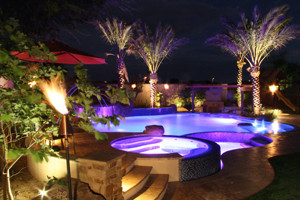Plant Selection
Arizona Landscaping, Phoenix Landscaping, Uncategorized
 Without a doubt, plants are the foundation of our outdoor environment. The diversity of plant species and the multitude of cultivars, hybrids and varieties make for creative and appealing landscape compositions. There are a number of reasons for choosing plants for the landscape. We may be attracted to their ornamental appeal or call upon them to serve a specific function or purpose in the landscape, such as providing a screen, blocking unwanted views, or stabilizing a soil bank. Others may be selected because of their ability to adapt to poor soils or simply for the ease of subsequent care. Generally, when horticulturists are asked about plants, responding is not as simple as blurting out a few names. Plant selection is an organized process that examines several factors: function, aesthetics, site adaptability and management. The priority placed on each category varies with the individual. The freedom to choose from a wide variety of plants depends on the flexibility or restrictions imposed by the individual, the site, or in some cases the local availability of plants.
Without a doubt, plants are the foundation of our outdoor environment. The diversity of plant species and the multitude of cultivars, hybrids and varieties make for creative and appealing landscape compositions. There are a number of reasons for choosing plants for the landscape. We may be attracted to their ornamental appeal or call upon them to serve a specific function or purpose in the landscape, such as providing a screen, blocking unwanted views, or stabilizing a soil bank. Others may be selected because of their ability to adapt to poor soils or simply for the ease of subsequent care. Generally, when horticulturists are asked about plants, responding is not as simple as blurting out a few names. Plant selection is an organized process that examines several factors: function, aesthetics, site adaptability and management. The priority placed on each category varies with the individual. The freedom to choose from a wide variety of plants depends on the flexibility or restrictions imposed by the individual, the site, or in some cases the local availability of plants.
 Viewing plant selection as a process may at first seem cumbersome, but in time the process can make it easier to make decisions and provide more choices than first thought. Function or purpose defines the reason for using a plant. Looking good certainly justifies a selection, but the value of a plant may go far beyond aesthetic appeal. Function guides the selection of a plant type, such as tree, shrub, or perennial for a specific space. Plants are packaged in many ways – their aesthetic qualities are as diverse as the species we have to choose from. Plant aesthetic qualities include the overall habit or shape of the plant and its foliage, flowers, fruit, and bark. The combinations of plant forms, foliage, flowers, fruit and bark can result in creative, artistic displays.
Viewing plant selection as a process may at first seem cumbersome, but in time the process can make it easier to make decisions and provide more choices than first thought. Function or purpose defines the reason for using a plant. Looking good certainly justifies a selection, but the value of a plant may go far beyond aesthetic appeal. Function guides the selection of a plant type, such as tree, shrub, or perennial for a specific space. Plants are packaged in many ways – their aesthetic qualities are as diverse as the species we have to choose from. Plant aesthetic qualities include the overall habit or shape of the plant and its foliage, flowers, fruit, and bark. The combinations of plant forms, foliage, flowers, fruit and bark can result in creative, artistic displays.
 Once we have identified the potential aesthetic qualities, the next question is to determine whether or not the plant will truly perform in the soil and environmental conditions on your property. A helpful adage is “Don’t fight the site.” If you test or challenge Mother Nature and pick a plant that does not match your site conditions, there is a good chance that it will fail. Factors related to site adaptability – such as the plant’s cold hardiness and tolerance for site conditions such as soil type, exposure and light levels – will define whether your aesthetic selections will perform to your expectations. The final consideration in plant selection is management. Landscape management or maintenance guides the development of plants in the landscape. After initial establishment, accent plants start to show off their qualities, plant masses begin to integrate, and border plantings achieve their intended shape. It is the feasibility and quality of maintenance that ensures the long-term aesthetic appeal of any plant and certainly highlights its contribution to the overall appeal of the landscape.
Once we have identified the potential aesthetic qualities, the next question is to determine whether or not the plant will truly perform in the soil and environmental conditions on your property. A helpful adage is “Don’t fight the site.” If you test or challenge Mother Nature and pick a plant that does not match your site conditions, there is a good chance that it will fail. Factors related to site adaptability – such as the plant’s cold hardiness and tolerance for site conditions such as soil type, exposure and light levels – will define whether your aesthetic selections will perform to your expectations. The final consideration in plant selection is management. Landscape management or maintenance guides the development of plants in the landscape. After initial establishment, accent plants start to show off their qualities, plant masses begin to integrate, and border plantings achieve their intended shape. It is the feasibility and quality of maintenance that ensures the long-term aesthetic appeal of any plant and certainly highlights its contribution to the overall appeal of the landscape.